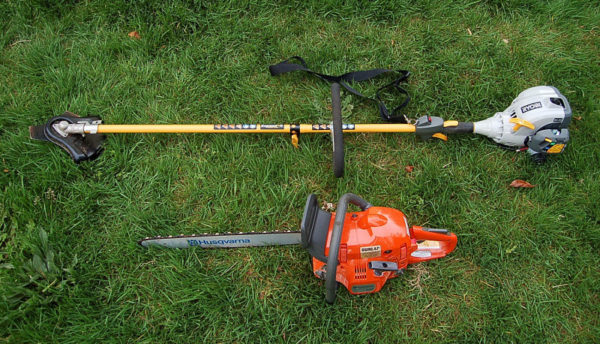Let’s face it, most chain saws and brush cutters are not particularly eco-friendly since they spew out lots of 2-stroke oil and gas smoke. Nonetheless, I needed to get both of these devices for making headway into our driveway area and future walking paths around the property. Hence, a dilemma. How best to strike the balance?
So I cranked up the Google machine, asked questions on the Mother Earth News forums, and reviewed model designs among the more established and reputable manufacturers (product longevity is also a more sustainable choice than low quality buy-and-toss machines). After doing a bunch of research, this was what I came up with:
First, I expected higher usage over the years ahead in terms of both frequency and amount of time these tools would be used. So, the economic benefits of renting them did not make sense for us, plus all the organizational, logistical, and transportation issues would add up over time. So, I looked for options to buy.
For the chain saw, there was surprisingly little easily discoverable information out there on low emissions chain saws. However, an occasional press release or green-washed ad would appear here and there. By following these tidbit trails, I was able to eventually hone in on purchasing a Husqvarna 450e. Husqvarna is one of the only chain saw companies that actually had an official environmental responsibility policy, and they have developed new engine designs plus low-smoke oil to help toward this goal.
The Husqvarna 450e was one of their newest models, located on the high end of their consumer line just below their professional line. My primary interest was in the X-Torq engine design with new E-Tech II catalytic emission control features. The X-Torq technology was primarily different in the way it mixed combustion air. By using a second clean air stream in addition to the usual single fuel/oil mix air stream, Husqvarna claimed up to 20% better fuel economy and 60% reduced emissions compared to regular 2-stroke chain saw engines of the same class.
The 450e also had other design benefits for general use:
- Easy start with engine compression switch, auto-return stop switch, and fuel pump
- Snap-lock cylinder cover
- Tool-less chain tensioning
- Visible fuel level
- Felling marks
- Vibration dampening system
- Inertia-activated chain brake and hand protection safety features
So, the 450e was the one. I had to do a lot of hunting around to find one in stock at an area store, but was able to do so with the helpful folks at Dunlap Industrial Hardware in Everett.
For the brush cutter, I was able to find a decent model at Home Depot: the Riyobi BC30. There were higher quality (and more expensive) models out there. But for our limited use of a brush cutter, this basic one served our purposes. It was certified EPA Phase II and California Air Resources Board (CARB) Tier II low emission compliant, which were both current certifications indicating the better end of the 2-stroke engine emission scale.
The Riyobi included a pre-attached tri-blade brush cutter plus 2 separate swappable string trimmer head attachments. A shoulder harness was provided for safety to ensure the blade always stayed away from the user’s body, even if a kick-back or weird swing occurred.
We are all set to start whacking and cutting our way along the old logging road into our property!
[Later note: The Riyobi eventually stopped running entirely and the cost of fixing it was more than the cost of its purchase. I eventually transitioned to all-electric battery-powered EGO chainsaws, brush cutters, and other landscaping/forestry equipment.]



STAY INFORMED WITH OUR NEWSLETTER
SEARCH
CATEGORIES
ARCHIVES